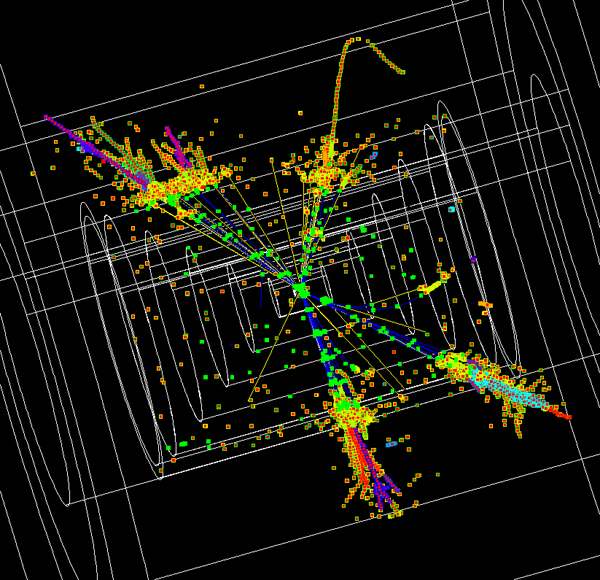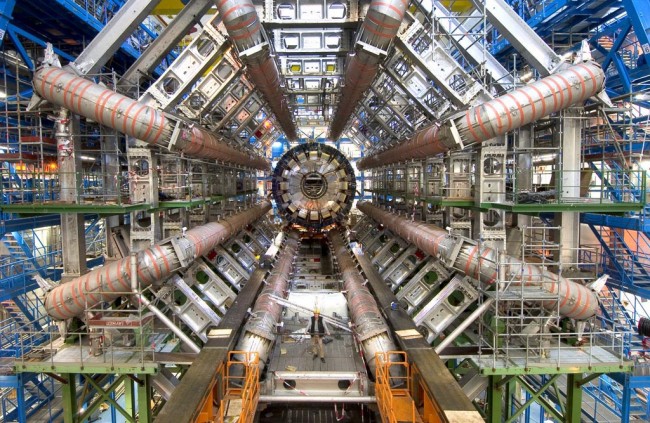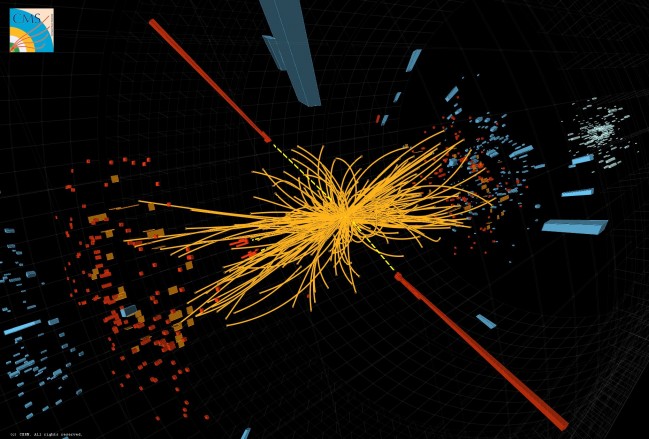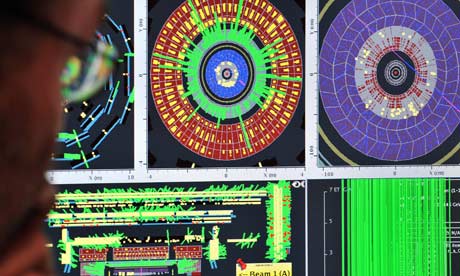
CERN’s Large Hadron Collider (LHC) smashed countless particles into one another to reveal the Higgs Boson. A great achievement for all concerned. Yet what of the still remaining “big questions” of physics, and how will we find the answers?
From Wired:
The current era of particle physics is over. When scientists at CERN announced last July that they had found the Higgs boson — which is responsible for giving all other particles their mass — they uncovered the final missing piece in the framework that accounts for the interactions of all known particles and forces, a theory known as the Standard Model.
And that’s a good thing, right? Maybe not.
The prized Higgs particle, physicists assumed, would help steer them toward better theories, ones that fix the problems known to plague the Standard Model. Instead, it has thrown the field into a confusing situation.
“We’re sitting on a puzzle that is difficult to explain,” said particle physicist Maria Spiropulu of Caltech, who works on one of the LHC’s main Higgs-finding experiments, CMS.
It may sound strange, but physicists were hoping, maybe even expecting, that the Higgs would not turn out to be like they predicted it would be. At the very least, scientists hoped the properties of the Higgs would be different enough from those predicted under the Standard Model that they could show researchers how to build new models. But the Higgs’ mass proved stubbornly normal, almost exactly in the place the Standard Model said it would be.
To make matters worse, scientists had hoped to find evidence for other strange particles. These could have pointed in the direction of theories beyond the Standard Model, such as the current favorite supersymmetry, which posits the existence of a heavy doppelganger to all the known subatomic bits like electrons, quarks, and photons.
Instead, they were disappointed by being right. So how do we get out of this mess? More data!
Over the next few years, experimentalists will be churning out new results, which may be able to answer questions about dark matter, the properties of neutrinos, the nature of the Higgs, and perhaps what the next era of physics will look like. Here we take a look at the experiments that you should be paying attention to. These are the ones scientists are the most excited about because they might just form the next cracks in modern physics.
ALTAS and CMS
The Large Hadron Collider isn’t smashing protons right now. Instead, engineers are installing upgrades to help it search at even higher energies. The machine may be closed for business until 2015 but the massive amounts of data it has already collected is still wide open. The two main Higgs-searching experiments, ATLAS and CMS, could have plenty of surprises in store.
“We looked for the low-hanging fruit,” said particle physicist David Miller of the University of Chicago, who works on ATLAS. “All that we found was the Higgs, and now we’re going back for the harder stuff.”
What kind of other stuff might be lurking in the data? Nobody knows for sure but the collaborations will spend the next two years combing through the data they collected in 2011 and 2012, when the Higgs was found. Scientists are hoping to see hints of other, more exotic particles, such as those predicted under a theory known as supersymmetry. They will also start to understand the Higgs better.
See, scientists don’t have some sort of red bell that goes “ding” every time their detector finds a Higgs boson. In fact, ATLAS and CMS can’t actually see the Higgs at all. What they look for instead are the different particles that the Higgs decays into. The easiest-to-detect channels include when the Higgs decays to things like a quark and an anti-quark or two photons. What scientists are now trying to find out is exactly what percent of the time it decays to various different particle combinations, which will help them further pin down its properties.
It’s also possible that, with careful analysis, physicists would add up the percentages for each of the different decays and notice that they haven’t quite gotten to 100. There might be just a tiny remainder, indicating that the Higgs is decaying to particles that the detectors can’t see.
“We call that invisible decay,” said particle physicist Maria Spiropulu. The reason that might be exciting is that the Higgs could be turning into something really strange, like a dark matter particle.
We know from cosmological observations that dark matter has mass and, because the Higgs gives rise to mass, it probably has to somehow interact with dark matter. So the LHC data could tell scientists just how strong the connection is between the Higgs and dark matter. If found, these invisible decays could open up a whole new world of exploration.
“It’s fashionable to call it the ‘dark matter portal’ right now,” said Spiropulu.
NOVA and T2K
Neutrinos are oddballs in the Standard Model. They are tiny, nearly massless, and barely like interacting with any other members of the subatomic zoo. Historically, they have been the subject of many surprising results and the future will probably reveal them to be even stranger. Physicists are currently trying to figure out some of their properties, which remain open questions.
“A very nice feature of these open questions is we know they all have answers that are accessible in the next round of experiments,” said physicist Maury Goodman of Argonne National Laboratory.
The US-based NOvA experiment will hopefully pin down some neutrino characteristics, in particular their masses. There are three types of neutrinos: electron, muon, and tau. We know that they have a very tiny mass — at least 10 billion times smaller than an electron — but we don’t know exactly what it is nor which of the three different types is heaviest or lightest.
NOvA will attempt to figure out this mass hierarchy by shooting a beam of neutrinos from Fermilab near Chicago 810 kilometers away to a detector in Ash River, Minnesota. A similar experiment in Japan called T2K is also sending neutrinos across 295 kilometers. As they pass through the Earth, neutrinos oscillate between their three different types. By comparing how the neutrinos look when they are first shot out versus how they appear at the distant detector, NOvA and T2K will be able to determine their properties with high precision.
T2K has been running for a couple years while NOvA is expected to begin taking data in 2014 and will run six years. Scientists hope that they will help answer some of the last remaining questions about neutrinos.
Read the entire article here.
Image: A simulation of the decay of a Higgs boson in a linear collider detector. Courtesy of Norman Graf / CERN.




 We think CDM sounds much more fun than LHC, a rather dry acronym for Large Hadron Collider.
We think CDM sounds much more fun than LHC, a rather dry acronym for Large Hadron Collider. Two exciting races tracked through Grenoble, France this passed week. First, the Tour de France held one of the definitive stages of the 2011 race in Grenoble, the individual time trial. Second, Grenoble hosted the
Two exciting races tracked through Grenoble, France this passed week. First, the Tour de France held one of the definitive stages of the 2011 race in Grenoble, the individual time trial. Second, Grenoble hosted the  Both colliders have been smashing particles together in their ongoing quest to refine our understanding of the building blocks of matter, and to determine the existence of the Higgs particle. The Higgs is believed to convey mass to other particles, and remains one of the remaining undiscovered components of the Standard Model of physics.
Both colliders have been smashing particles together in their ongoing quest to refine our understanding of the building blocks of matter, and to determine the existence of the Higgs particle. The Higgs is believed to convey mass to other particles, and remains one of the remaining undiscovered components of the Standard Model of physics. [div class=attrib]From Discover:[end-div]
[div class=attrib]From Discover:[end-div]